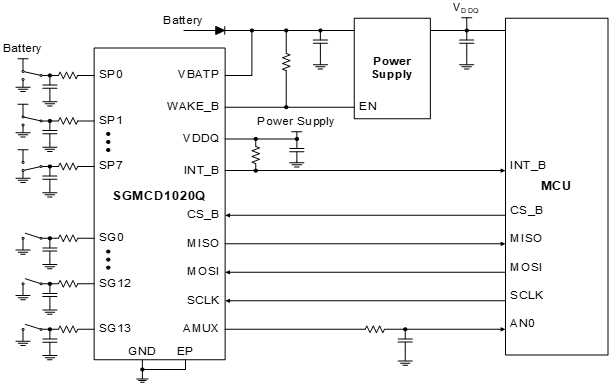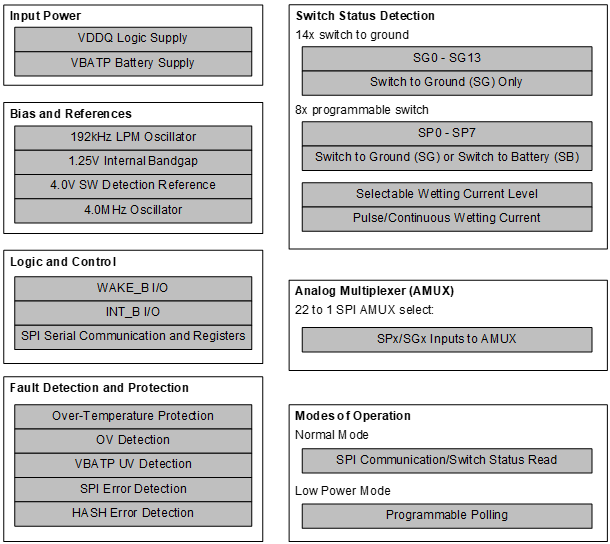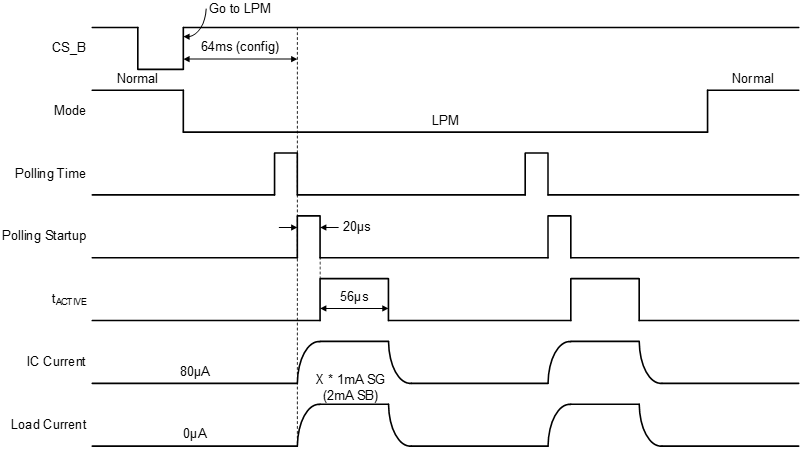SG Micro Corp has launched the automotive-grade Multi-Switch Detection Interface (MSDI) chip SGMCD1020Q, bringing a new solution for the body control module. This chip has excellent multi-channel detection capabilities and can accurately monitor the switch status of up to 22 channels, including 14 ground switches and 8 programmable switches (which can be flexibly configured as ground switches or battery switches). With its Serial Peripheral Interface (SPI), the SGMCD1020Q can efficiently transmit switch status information to the Microcontroller Unit (MCU), ensuring timely system response. In addition, the chip has a built-in 22-to-1 analog multiplexer that can output the buffered selected input analog signal to the AMUX pin for further reading and processing by the MCU, fully meeting the high-performance requirements of automotive electronic systems for switch detection.
The SGMCD1020Q has three flexible operation modes: Normal Mode, Low-Power Mode, and Polling Mode. In the normal mode, the device can be programmed, and when a change in the switch status is detected, it provides accurate pull-up or pull-down wet current for the switch contacts; the low-power mode achieves ultra-low power operation by turning off most of its own circuits, and its typical standby current is extremely low, which is very suitable for automotive and industrial scenarios with strict requirements for sleep current and can significantly reduce system energy consumption; the polling mode will detect the input pins according to the preset cycle and quickly determine whether the switch status has changed compared to the normal mode, providing an efficient and flexible detection method for the system.
The SGMCD1020Q complies with the AEC-Q100 standard and is suitable for automotive applications. The chip uses an environmentally friendly TQFN-5×5-32GL green package, and the operating temperature range is from -40°C to +125°C.




Figure 1 Typical Application Circuit of SGMCD1020Q
Figure 2 Functional Block Diagram of SGMCD1020Q
Typical Characteristics of SGMCD1020Q
SG Micro Corp
Complies with the automotive reliability standard AEC-Q100 Grade 1;
Supports 12V automotive systems and has under-voltage and over-voltage warning functions;
Full parameter operating voltage: 6V ≤ VBATP ≤ 28V;
Full-function operating voltage: 6V ≤ VBATP ≤ 36V;
Switch input voltage range of SGx and SPx: -1V to 36V;
Typical standby current: IBATP = 70μA, IVDDQ = 4.4μA;
Supports three operating modes: Normal Mode, Low-Power Mode, and Polling Mode;
14 ground switches, 8 programmable switches (ground switches or battery switches);
4 configurable wet current settings: 2mA, 8mA, 12mA, 16mA;
Selectable wake-up function for switch status change;
Actively generates an interrupt (INT_B) when the switch status changes;
Can be directly connected to the MCU using the 3.3V/5.0V SPI protocol;
Uses an environmentally friendly TQFN-5×5-32GL green package.
SG Micro Corp
Complies with the automotive reliability standard AEC-Q100 Grade 1;
Supports 12V automotive systems and has under-voltage and over-voltage warning functions;
Full parameter operating voltage: 6V ≤ VBATP ≤ 28V;
Full-function operating voltage: 6V ≤ VBATP ≤ 36V;
Switch input voltage range of SGx and SPx: -1V to 36V;
Typical standby current: IBATP = 70μA, IVDDQ = 4.4μA;
Supports three operating modes: Normal Mode, Low-Power Mode, and Polling Mode;
14 ground switches, 8 programmable switches (ground switches or battery switches);
4 configurable wet current settings: 2mA, 8mA, 12mA, 16mA;
Selectable wake-up function for switch status change;
Actively generates an interrupt (INT_B) when the switch status changes;
Can be directly connected to the MCU using the 3.3V/5.0V SPI protocol;
Uses an environmentally friendly TQFN-5×5-32GL green package.
Product Advantages of SGMCD1020Q
SG Micro Corp
In the automotive electronic system, the Body Control Module (BCM) is the core component used to manage various body functions. Compared with the traditional discrete detection scheme for switch interfaces, the SGMCD1020Q, with its highly integrated design, ultra-low power consumption characteristics, rich detection functions, convenient communication interface, and excellent reliability, brings an all-round performance improvement to the BCM. It can not only optimize the overall performance of the automotive electronic system but also significantly reduce the system cost. At the same time, it greatly improves the stability and reliability of the system, providing a better solution for the design and application of automotive electronic systems.
I. Highly Integrated, Saving Space and Cost
The SGMCD1020Q integrates a 22-channel switch detection interface and a 22-to-1 analog multiplexer, which can detect multiple switch statuses simultaneously and process analog input signals. Compared with the traditional discrete scheme, this chip significantly reduces the number of required external components, such as resistors, capacitors, and diodes. This highly integrated design not only reduces the occupation of MCU resources but also greatly reduces the circuit board space, reduces the cost of component procurement and production, simplifies the design process, and improves the system reliability.

SG Micro Corp
In the automotive electronic system, the Body Control Module (BCM) is the core component used to manage various body functions. Compared with the traditional discrete detection scheme for switch interfaces, the SGMCD1020Q, with its highly integrated design, ultra-low power consumption characteristics, rich detection functions, convenient communication interface, and excellent reliability, brings an all-round performance improvement to the BCM. It can not only optimize the overall performance of the automotive electronic system but also significantly reduce the system cost. At the same time, it greatly improves the stability and reliability of the system, providing a better solution for the design and application of automotive electronic systems.
I. Highly Integrated, Saving Space and Cost
The SGMCD1020Q integrates a 22-channel switch detection interface and a 22-to-1 analog multiplexer, which can detect multiple switch statuses simultaneously and process analog input signals. Compared with the traditional discrete scheme, this chip significantly reduces the number of required external components, such as resistors, capacitors, and diodes. This highly integrated design not only reduces the occupation of MCU resources but also greatly reduces the circuit board space, reduces the cost of component procurement and production, simplifies the design process, and improves the system reliability.

Figure 3 Discrete Detection Scheme for Switch Interface
II. Low-Power Mode, Helping with Energy Saving and Consumption Reduction
The SGMCD1020Q has a low-power mode, with a typical standby current of only 70μA for IBATP and 4.4μA for IVDDQ. This feature makes it perform excellently in application scenarios such as automobiles with strict requirements for low sleep state current, which can significantly reduce system power consumption, effectively extend the battery life of the automobile, and improve the overall efficiency of the automotive electrical system. The traditional discrete detection scheme is difficult to achieve such a low power consumption level.
III. High Reliability, Ensuring Stable System Operation
The SGMCD1020Q has a variety of protection and fault detection mechanisms, including under-voltage, over-voltage, overheat protection, and SPI communication error detection functions. In the complex and changeable electrical environment of automobiles, these mechanisms can effectively deal with various abnormal situations, ensure stable system operation, and significantly reduce the probability of failures. In addition, the device can still operate normally under abnormal conditions such as ground offset and short circuit, showing excellent reliability, which is more outstanding than the traditional discrete detection scheme.
IV. Rich Functions, Enhancing Detection Flexibility
The SGMCD1020Q can flexibly adapt to diverse switch detection requirements through software configuration. When there is a need to add new switch functions or expand the system functions, only software upgrades and a small amount of hardware adjustment are required to quickly achieve function upgrades. There is no need to redesign and layout a large number of circuits like in the discrete scheme, which greatly enhances the scalability and flexibility of the system. Its main functions are as follows:
Programmable Four-level High-precision Wet Current: It provides four levels of wet current, namely 2mA, 8mA, 12mA, and 16mA, which can be flexibly configured according to different detection requirements. A small current is suitable for detecting the state of analog switches, which is conducive to the ADC achieving finer resolution within the full-scale range; a large current can effectively remove the oxidation effect of mechanical switch contacts, and at the same time, it has a stronger ability to source and sink external capacitive currents, significantly shortening the response time.
Programmable Wet Current Duration: It supports continuous or pulse modes, and the duration of the wet current can be flexibly configured according to specific application scenarios to meet different switch detection requirements.
Programmable Polling Cycle: In the polling mode, the polling cycle can be flexibly configured within the range of 3ms to 128ms, with a total of 16 levels provided to meet the requirements of different detection frequencies.
Selectable Wake-up Function: When the switch status changes, it can actively send a notification to the MCU, improving the system's response speed and real-time performance, and ensuring a quick response to switch operations.
Efficient and Stable Communication: It supports the 3.3V/5.0V SPI protocol and can directly communicate with the MCU to ensure the efficiency and stability of data transmission, further optimizing the system performance.


With its characteristics of high integration, low power consumption, high reliability, and rich functions, the SGMCD1020Q perfectly meets the strict requirements of modern automotive electronic systems for switch detection interfaces. It provides an efficient, energy-saving, and reliable solution for the Body Control Module (BCM), which will strongly promote the development and upgrade of automotive electronic systems and bring a better product experience to automobile manufacturers and users.
The SGMCD1020Q has a low-power mode, with a typical standby current of only 70μA for IBATP and 4.4μA for IVDDQ. This feature makes it perform excellently in application scenarios such as automobiles with strict requirements for low sleep state current, which can significantly reduce system power consumption, effectively extend the battery life of the automobile, and improve the overall efficiency of the automotive electrical system. The traditional discrete detection scheme is difficult to achieve such a low power consumption level.
III. High Reliability, Ensuring Stable System Operation
The SGMCD1020Q has a variety of protection and fault detection mechanisms, including under-voltage, over-voltage, overheat protection, and SPI communication error detection functions. In the complex and changeable electrical environment of automobiles, these mechanisms can effectively deal with various abnormal situations, ensure stable system operation, and significantly reduce the probability of failures. In addition, the device can still operate normally under abnormal conditions such as ground offset and short circuit, showing excellent reliability, which is more outstanding than the traditional discrete detection scheme.
IV. Rich Functions, Enhancing Detection Flexibility
The SGMCD1020Q can flexibly adapt to diverse switch detection requirements through software configuration. When there is a need to add new switch functions or expand the system functions, only software upgrades and a small amount of hardware adjustment are required to quickly achieve function upgrades. There is no need to redesign and layout a large number of circuits like in the discrete scheme, which greatly enhances the scalability and flexibility of the system. Its main functions are as follows:
Programmable Four-level High-precision Wet Current: It provides four levels of wet current, namely 2mA, 8mA, 12mA, and 16mA, which can be flexibly configured according to different detection requirements. A small current is suitable for detecting the state of analog switches, which is conducive to the ADC achieving finer resolution within the full-scale range; a large current can effectively remove the oxidation effect of mechanical switch contacts, and at the same time, it has a stronger ability to source and sink external capacitive currents, significantly shortening the response time.
Programmable Wet Current Duration: It supports continuous or pulse modes, and the duration of the wet current can be flexibly configured according to specific application scenarios to meet different switch detection requirements.
Programmable Polling Cycle: In the polling mode, the polling cycle can be flexibly configured within the range of 3ms to 128ms, with a total of 16 levels provided to meet the requirements of different detection frequencies.
Selectable Wake-up Function: When the switch status changes, it can actively send a notification to the MCU, improving the system's response speed and real-time performance, and ensuring a quick response to switch operations.
Efficient and Stable Communication: It supports the 3.3V/5.0V SPI protocol and can directly communicate with the MCU to ensure the efficiency and stability of data transmission, further optimizing the system performance.


With its characteristics of high integration, low power consumption, high reliability, and rich functions, the SGMCD1020Q perfectly meets the strict requirements of modern automotive electronic systems for switch detection interfaces. It provides an efficient, energy-saving, and reliable solution for the Body Control Module (BCM), which will strongly promote the development and upgrade of automotive electronic systems and bring a better product experience to automobile manufacturers and users.

